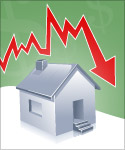
Categories are graded from A thru F:
Economic Growth: C-
Economic growth trends were mixed this month, as several key metrics ticked up while others ticked down. The employment market improved once again as year-over-year employment growth has now been positive for seven consecutive months, and unemployment now stands at its lowest level since March 2009.
In addition, retail sales improved this month, while real GDP for the fourth quarter was revised slightly higher to 3.1%. On the downside, the rate of inflation (both full and core) continues to increase, while the average length of unemployment increased to an all-time high, currently at 39 weeks.
Affordability: D+
Affordability has rarely been better for entry-level buyers, and rarely worse for move-up and move-down buyers, who need to extract equity from their existing home. As such, we continue to grade our overall affordability indicator at a D+. After increasing every quarter from Q1-2009 through Q2-2010, owner equity declined for the second consecutive quarter in Q4-2010; a reflection of the continued downward pressure on home prices.
Mortgage rates remain near historical lows, and home prices have dropped from unrealistic boom levels to entirely sustainable levels, with some markets like Las Vegas well into “over-correction” territory. Our housing-cost-to-income ratio remains low, now at 22.4%, and our JBREC Affordability index stands at a remarkable 0.0, which is the highest possible rating for affordability. The median home price-to-income ratio has declined to 2.8, which is less than the long-term historical norm and near a level conducive to market health.
Affordability continues to be bolstered by historically low mortgage rates. The 30-year fixed mortgage rate is currently at 4.86% and adjustable mortgage rates are at 3.26%, both down from last month. The Fed's overnight lending target rate remained at a range of 0.00% to 0.25%, which is the lowest level on record. The share of ARM applications is currently at 5.7%, which is still far below the peak level of 35% of total applications in early 2005.
Leading Indicators: C
The leading indicators for the economy are somewhat better this month versus last month. The ECRI Leading Index continues to rise on a year-over-year basis, now up for the fourth consecutive month. In addition, the CEO Economic Outlook Survey also rose, currently at its highest point since records began in 2002. Other leading indicators such as the Small Business Optimism index and ISM Business Activity indices declined versus last month.
Stocks were relatively unchanged this month for the four major indices we track, with losses/gains ranging from -0.2% (NASDAQ) to +1.02% (Dow Jones). The S&P Homebuilding Index has worsened month-over-month, falling 2.3%. Corporate bond spreads have narrowed, while 10-year and 2-year Treasury rates fell for the month. Oil prices continued to rise this month and are currently above $100/barrel for the first time since summer 2008.
Consumer Behavior: D+
Consumer behavior worsened this month, with several metrics worse than last month. The Consumer Confidence Index, Consumer Sentiment Index (largest sequential drop since October 2008), and the Consumer Comfort Index all decreased this month. Due to rising inflation, the misery index (unemployment + inflation) also worsened this month.
Existing Home Market: D+
The existing home market worsened this month as all metrics ticked down aside from the pending home sales index and purchase mortgage application index. According to the National Association of Realtors, seasonally adjusted annual resale activity decreased to 4.88 million homes and median resale prices fell further into the red, now down 4.2% year-over-year. The S&P/Case-Shiller 10 and 20 market composite indices also fell this month, while existing home inventory and months of supply increased.
New Home Market: C-
The new home market worsened this month. New home sales decreased to 250,000 units on an annualized basis, hitting a new historical low that dates back to 1963 when the Census Bureau began tracking this data point. It should be noted, however, that the sample size used by the Census Bureau to calculate new home sales is extremely small and the confidence interval consequently large. The median single-family new home price also decreased to $202,100 this month (a new low for this down cycle) and is currently down 7.4% year-over-year. The months of unsold homes metric increased to 8.9 months. Builder confidence remained relatively unchanged this month as the Housing Market Index ticked up from 16 to 17, still far below its historical average of 50.
Repairs and Remodeling: D+
Aside from private residential construction, conditions for residential repairs and remodeling improved this month. Residential investment as a percentage of GDP was revised slightly higher to 2.3% this quarter, and increased on an absolute level. Homeowner improvement activity has actually returned to positive territory for the past three quarters, climbing 3.9% year-over-year, and is much better than the severe declines experienced a couple of years ago. The Remodeling Market Index (current) was relatively flat this quarter, dropping from 43.4 to 43.3, still below its historical average of 46.4. That said, the Remodeling Market Index (future expectations) rose.
Housing Supply: F
Housing supply indicators are somewhat worse this month, with all except one indicator grading at an F. Single-family permits decreased to 382,000 units, and single-family starts decreased to 375,000 units. Both of these activity levels remain low by historical standards.
New housing units completed increased this month, while manufactured housing placements decreased. Vacancy rates in the U.S. have improved in recent quarters, but the majority of the U.S. remains oversupplied historically, with only three small population states under-supplied. The homeowner vacancy rate increased this quarter to 2.7%.
* US Building Market Intelligence™ report is produced by John Burns Real Estate Consulting.



